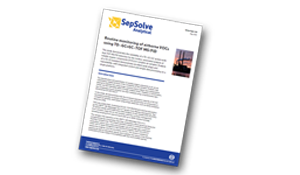This study from SepSolve Inc. demonstrates the suitability of a TD–GC×GC system with dual TOF MS/FID detection for the routine, automated analysis of volatile organic compounds (VOCs) in complex air samples.
 Introduction
Introduction
The identification and quantitation of volatile organic pollutants in air can be challenging, largely because of the complexity of the samples. Analysts may attempt to address this using longer columns and/or slower oven temperature ramps, but this inevitably leads to longer analysis times. However, in recent years, the complexity of such samples has been revealed using comprehensive two-dimensional GC (GC×GC).
In this study, we demonstrate how the increased separation capacity of GC×GC techniques provides increased confidence in the identification of compounds in complex air samples, even when using simple detectors, such as flame ionisation detection (FID).
Flow-modulated GC×GC–TOF MS/FID is coupled with thermal desorption on the UNITY–CIA Advantage-Kori-xr™ system. This TD system allows automated trace-level analysis of very volatile VOC and VOCs
from canisters, bags and on-line samples, with Kori-xr water management allowing sampling from environments with up to 100% relative humidity.
This study demonstrates that:
- The TD–GC×GC–TOF MS system described offers excellent chromatography, repeatability and ease-of-use for routine monitoring of the full range of TO-15 air pollutants, without requiring liquid cryogen.
- A high degree of analyte separation is possible using GC×GC, and this is assisted by the excellent peak shape resulting from the use of thermal desorption preconcentration and the reverse fill/flush dynamics of the INSIGHT® flow modulator.
- In contrast to thermally-modulated systems, INSIGHT does not suffer from any volatility constraints, enabling efficient modulation of volatiles from C1 upwards.




